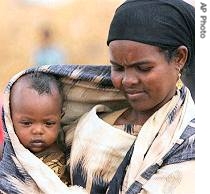2007年VOA标准英语-Malnutrition Alarming in Kenya Refugee Camps
搜索关注在线英语听力室公众号:tingroom,领取免费英语资料大礼包。
(单词翻译)
By Lisa SchleinGeneva
03 July 2007
U.N. agencies are warning malnutrition1 rates in refugee camps in Kenya have reached alarming levels. The U.N. Refugee Agency, World Food Program and U.N. Children's Fund are urgently appealing for $32 million to reverse this situation. Lisa Schlein reports for VOA from Geneva.

Somali woman holding her child at a Dadaab refugee camp in Northern Kenya (File Photo)
Twenty four million dollars is to go to the World Food Program, which needs a lot of cash to buy highly enriched food for the Kenyan refugee camps.
A U.N. survey shows the acute malnutrition rate in the Dadaab camps is higher than 22 percent and in Kakuma camp it is nearly 16 percent. This is well above the World Health Organization's emergency threshold of 15 percent.
U.N. Children's Fund spokeswoman, Miranda Eels2, says an increasing number of people, especially children, are getting ill because of their weakened condition.
"Over the past year, cholera3, measles4, meningitis and Kenya's first case of polio in 20 years was recorded in the camps, worsening the fragile nutritional5 status of young children," she said. "So, UNICEF needs just under $600,000 to support the management of high acute malnutrition and tackle underlying6 causes that include poor infant feeding and breast feeding practices."
Eels says there is a critical need for complementary foods such as ground nuts that provide extra nutrients7, supplementary8 feeding for more children, and therapeutic9 feeding to treat dangerously malnourished children.
The Dadaab complex of three refugee camps hosts some 175,000 refugees, mainly from Somalia. This includes about 35,000 children under age five. Kakuma camp houses 62,000 people. More than 10 percent of the population is children.
The camps are in harsh, semi-arid environments. The Kenyan government does not allow the refugees to work outside the camps or to farm or graze livestock10. This means the refugees are almost totally dependent on international aid.
U.N. refugee spokeswoman Jennifer Pagonis says her agency is chronically11 under funded and has not been able to provide essential nutrition services, complementary foods, and non-food items to the refugees.
"In Kenya, they have received about 15 percent less of the firewood that they need, half the quantity of soap," said Pagonis. "They do not receive as much water as they should. And, so what has been happening is that refugees have been selling food to try and make up these other essential supplies that they lack."
Pagonis explains this current emergency is a result of a complex of factors. Last year, she notes, about 34,000 refugees fleeing conflict in Somalia fled to Kenya. She says this meant more mouths to feed on an already limited budget.
Bad luck struck again, she says, when extensive floods destroyed portions of the camps and cut off Dadaab from supply routes for nearly two months. She says the floods displaced hundreds of families within the camps, adding to an already difficult situation.
 收听单词发音
收听单词发音 




